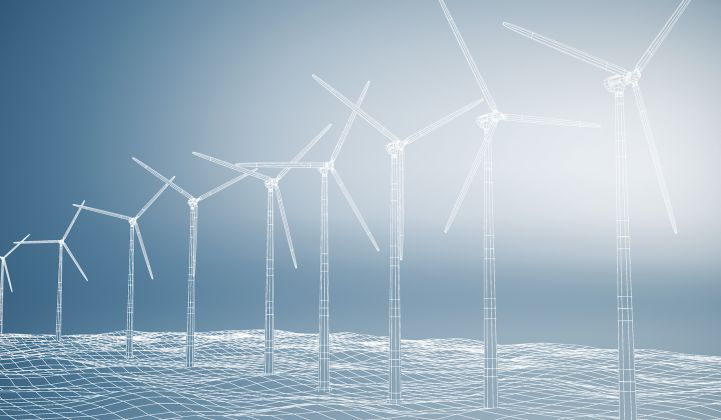The towers and foundations for offshore wind turbines currently being deployed at sea, and the even larger machines under development, are so massive that shipping the components via road or rail is becoming increasingly difficult, if not impossible.
To address the issue, a startup founded by a former National Renewable Energy Laboratory engineer aims to use concrete additive manufacturing, also known as 3D concrete printing, to build turbine towers and foundations at or near ports for less money and in less time than with conventional methods.
Last month, JC Solutions LLC, an RCAM Technologies company, received a $150,000 grant from a U.S. Department of Energy small business R&D program to develop the “first-ever conceptual design and techno-economic assessment of an additively manufactured concrete offshore wind turbine foundation and tower.”
The offshore project builds upon similar research under way in California, which was reported on by Greentech Media last November. There, the California Energy Commission awarded RCAM Technologies a $1.25 million grant to develop and test 3D concrete printing technology for onsite manufacturing of ultra-tall towers for land-based turbines.
With the new offshore project, “I don't have any plans to construct towers and foundations at sea, where the turbines are installed," said Jason Cotrell, RCAM Technologies founder and CEO, in an interview.
“All construction work would be done at the port, or near the port at a staging area — like a pre-cast concrete plant,” he added. “Such plants exist in nearly every region of the country. For near-site construction, the parts would be designed in sections that could be cost-effectively transported over local roads or rail.”
Potential capital cost, manufacturing time savings
Cotrell said that before learning of the DOE R&D funding opportunity he hadn’t given much thought to offshore applications of 3D concrete printing. Further impetus for the project was a DOE-backed University of Delaware report on ways to streamline offshore construction logistics, published in October 2017. That study’s lead author, Willet Kempton, as well as researchers from NREL, will advise on the new project.
Cotrell used figures on offshore wind project costs from Kempton’s study to inform his DOE proposal. For instance, the study found that the material costs for a jacket foundation — a latticed steel platform driven into the seafloor — is up to $6,000 per ton.
JC Solutions, meanwhile, intends to additively manufacture offshore turbine foundations and towers made of concrete and reinforcing basalt fiber together costing just $100 per ton, according to Cotrell. He estimates that 3D concrete printing can slash the capital cost to manufacture the finished turbine foundations and towers by up to 80 percent.
For comparison, he said, each steel jacket foundation for the 6-megawatt turbines installed at Rhode Island’s Block Island offshore wind farm cost up to $10 million. Cotrell is shooting for $2 million per installed foundation using 3D concrete printing.
He thinks he can build the components faster than with conventional methods, too. In his proposal for the DOE grant, Cotrell cited a figure stating it can take up to 135 days to manufacture the concrete or steel gravity-based foundation for an offshore turbine deployed in shallow water in Europe.
“If we’re running two printers at a time, I think I can build these towers in one to two weeks — in a production line approach,” he said.
He added that using 3D concrete printing to manufacture the foundation and tower enables the developer to avoid labor- and time-intensive custom work. Steel jacket foundations must be welded, the welds inspected and X-rayed, and then the structure primed and painted.
Delivering on tech promises
RCAM Technologies’ on- and offshore research projects soon will begin to test Cotrell’s cost-reduction and time-savings estimates.
Commenting on the 3D concrete printed ultra-tall tower project in California, Aaron Barr, a senior consultant with MAKE Consulting, told GTM, “Concrete towers have quickly emerged as a cost-effective alternative to steel tubular towers for hub heights over 120 meters.”
“Performing on-site pouring of concrete towers can present some cost savings in logistics and material cost and present one of the most promising applications of 3D printing in the wind energy industry," he added.
The big question for Barr: Can RCAM Technologies deliver on the estimated time savings? He wondered whether on-site pouring of concrete towers would increase the length of the installation cycle.
JC Solutions’ DOE grant runs for the next 12 months. After nine months, the company can apply for a $1 million Phase II grant under the same R&D program. While Phase I will look at port logistics and the conceptual design for the 3D concrete printed turbine foundation and tower, the focus of Phase II, if awarded, would be to build and test sub-scale or near-scale versions of these components in a laboratory.
Beyond the scope of Phase II would be the deployment of a 3D concrete printed structure at or near a port. “Once you’ve done that,” said Cotrell, “you’ve de-risked the technology substantially.”
Cotrell said he knows of one major turbine manufacturer — he did not want to name the company — interested in concrete additive manufacturing for towers.
“It’s validating that there is at least one major wind turbine manufacturer interested in this space,” he added.
Cotrell does not know if the company intends to pursue offshore applications. But, for Cotrell, that’s where the true promise of the technology lies.
“It makes even more sense offshore than it could for land-based turbines because of the constraints and size of these machines, and the inherent corrosion resistance of the materials that we’re using," he said.




